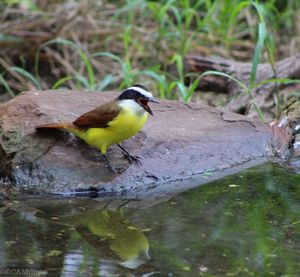Travel: Birding in McAllen, Texas
The stereotype of the avid birdwatcher is classic: a well-equipped enthusiast wearing the latest outdoor gear, carrying the biggest lens, peering into the trees through the most expensive binoculars, traveling to all the most exotic corners of the globe to be able to check another bird off the official life list.
But there are just as many of us who simply want to be where the birds are. We carry our mid-priced super-zoom cameras and our mid-priced binoculars and we take great pleasure in seeing the beautiful creatures that fill the air with music and the skies with color.
That’s what drew me to McAllen, Texas. As one of the premier birding locations in the country, the Rio Grande Valley of South Texas is home to 9 World Bird Centers. Thanks to the region’s temperate sub-tropical climate there are more than 400 species of birds which live in or pass through the area and, for the most part, you don’t need anything more than a good pair of eyes to see them.
Bentsen-Rio Grande State Park, just 5 miles from McAllen, is a birder’s delight. The 760-acre park adjoins another 1,700 acres of federal wildlife refuge. Cars are not allowed in the park but a trolley makes regular pick-ups along the 7 mile paved loop allowing birders to hitch a ride from one feeding station to the next. It’s a quiet, beautiful, place and it is filled with birds.
But the thing Bentsen offers that makes all the difference for the casual birder is a bird blind strategically placed near a feeding station. The hut made of horizontally-placed wood slats is reached by a ramp so it is accessible to those with disabilities. Inside the blind the wood slats can be folded down to form a platform for cameras so a tripod isn’t necessary to keep the camera steady. This makes it possible to get a pretty good photo with a point-and-shoot camera or even, if conditions are right, with a cellphone. All you have to do is sit and watch the show.
January and February are prime months for birdwatching and we were there on an unseasonably cold (for Texas) November day, during a weather event that had most of the country in the deep freeze. Temperatures hovered in the high 40s and the sky was overcast. But the birds kept coming to feed. I sat on a bench in the blind, peered through the opening and pressed the shutter again and again without disturbing the birds. Great Kiskadees swooped down in front of me and drank from the small pool of water. Green jays postured and fluttered at the feeders. A golden-fronted woodpecker fed at the peanut butter log. It was great fun.
When the trolly came around I surrendered my seat in the bird blind knowing I’d managed to get one or two good photos with what I had on hand. I don’t have a formal list, but I could have checked off a few that day:
Green jay. Check
Great Kiskadee. Check.
Golden-fronted woodpecker. Check
All for the price of the park’s $5 admission.
Birding can be an expensive hobby. But, in the right place, it can simply be great fun at little expense. I can see now how the whole enthusiast thing gets started, though. The one bird I’d heard so much about but didn’t get to see was the beautiful Altimira Oriole. I saw a nest that had been blown down in a storm but no bird, so I feel like I didn’t quite finish what I started. I guess I’ll have to go back to McAllen. With an official list.
Cheryl-Anne Millsap is the author of Home Planet: A Life in Four Seasons. Her audio essays can be heard on Spokane Public Radio and public radio stations across the country. She can be reached at catmillsap@gmail.com
